A War with a View
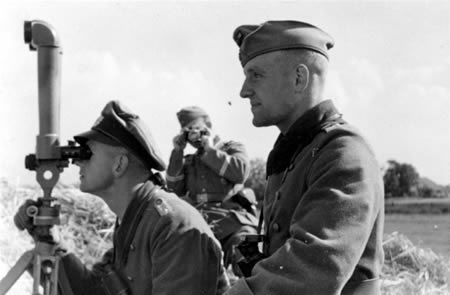
This photograph was taken on 1 September 1939, literally moments before World War II began with Germany’s invasion of Poland. While a photographer can be seen documenting the moment, a German Army officer peers through periscope binoculars to scan the Polish side of the border.
The instrument employed by the officer to gain a view of the impending war was most likely manufactured by Letiz, although Zeiss was also involved in designing and supplying such equipment to the Wehrmacht. The 14-power Scherenfernrohr 14 Ziel Gitter, or stereo binocular, served as a rangefinder for the artillery and was a mainstay of forward observers to gauge distances. The instrument’s periscope design also provided protection from snipers for the soldiers in the trenches.
Bicycle Soldiers
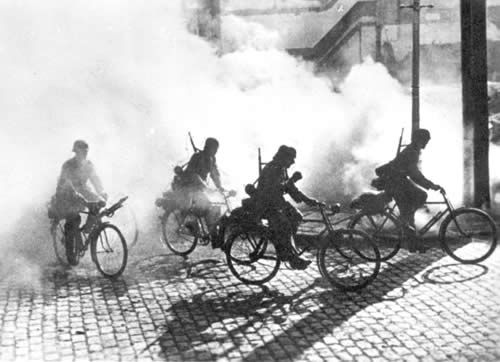
The German foot soldier also pedaled to war: the bicycle troops under the control of the Cavalry Brigade (the first formations appearing in 1936). Prior to hostilities, a regular bicycle troop consisted of 195 men, their mounts painted black and manufactured first in Germany, then as the war progressed the bicycles were from suppliers in Holland, Belgium and France.
While cycle soldiers wore uniforms much like those of the horse-mounted arm, they also wore an additional “cape.” A bicycle troop was equipped with nine light and two heavy machine guns and three 50mm mortars, its members receiving training similar to the infantry. The advantage of bicycles was that they moved with less noise than vehicles or even horses, and could traverse areas more quickly in some situations. The highly mobile bicycle troops were considered highly successful during the Western European campaign in 1940.
Blitzkrieg in 3-D
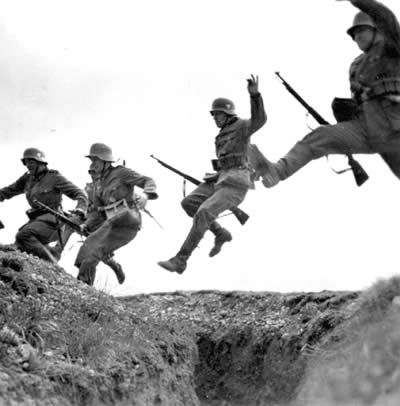
This photo, taken by acclaimed photographer P.K. Weber and titled “The Campaign in the West” - Photo Number 3 - was one of a series of stereoscopic images produced for the public in cooperation with the German military. The images were viewed through special glasses and produced a 3-D effect.
Iron horses
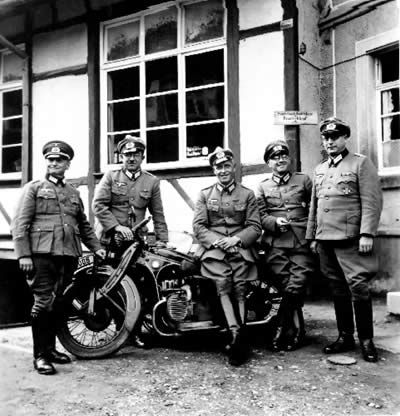
Officers pose with a brand new BMW. In late 1934 motorcycles entered service, with the 11th, 12th and 16th Horse Regiments becoming motorized rifle troops, in effect now riding “iron horses,” principally German-made BMWs and Zundapps.
The Germans’ mechanized lightning war required machines of high calibre in more ways than one. Although horses and even bicycles carried battalions of combatants, as did trucks and tracked vehicles, motorcycles led the way: purpose -made BMW and Zundapp military bikes as well as civilian models made by NSU and DKW, and a host of other makes that “served” either by contract or requisition.
Paratrooper
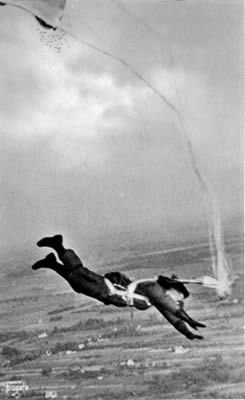
The postcard shows a parachutist at the moment his ‘chute will unfold. On the reverse a caption states: “Jumping into Nothingness.” With their first jumps executed in 1936, the Parachute Troops (Fallschirmtruppen) took part in the occupation of the Sudetenland and Czechoslovakia, and later were initially very successful in special airborne missions, including the dramatic takeover by a small force of the seemingly impenetrable Belgian fortress of Eben Emael.
They also took part in the invasions of Poland, Holland, Denmark, Norway and Greece and served in Russia as land infantry. The parachutists were badly mauled by British defenders during the attack on Crete in May 1941, after which Hitler was loathe to risk his èlite to airborne assaults, preferring to keep them earthbound.
Thousand Yard Stare
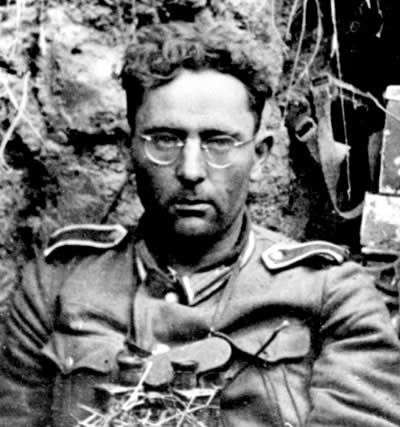
An officer sits in a foxhole on the frontline in Russia, his face telling the story of his ordeal. Oddly, the photo, not exactly a morale builder, was turned into a postcard, perhaps by the soldier himself.
The fearsome Russian winter with its minus 40 degrees and six-foot snow drifts would freeze motor oil solid in their vehicles and the lubricants in gun barrels, turning them useless. “General Winter” would bury thousands of infantrymen in its white shroud - over 30 percent of German deaths on the Eastern Front were caused by the freezing weather.
The lethally cold conditions were aggravated by the fact that during the first winter offensive of 1941-42, the German troops were equipped only with their summer uniforms, so certain were Hitler and his Generals that Russia would fall “like a rotten house of cards” before winter overtook them. Such arrogance spelled death for countless German soldiers and ultimately contributed to the loss of the war against the Soviet Union.
Credits
The images here have been supplied by G. Paul Garson, who has previously published three non-military related books and some 2000 magazine articles on a variety of subjects in the USA, England, France, Sweden, and the Russian Republic. The author lives and works in Los Angeles.
The Cameras and Cameramen
The photographs seen here, from the author’s collection, were all taken by German soldiers, a few by professionals “embedded” with the troops, but for the most part amateurs taking snapshots to chronicle their military service and as souvenirs for friends and family. The cameras used were often 35mm and produced by Leica, Agfa and Contax featuring advanced design and excellent optics and lenses. Most of the photos, when originally printed, measured only 3.5 x 2.5 inches while some were turned into personal postcards. Many once occupied extensive albums, since soldiers often kept very detailed accounts of their wartime experiences. Some returned with them after the war and years later were offered for sale by relatives, while other images were captured by the Soviets during the war and after the fall of the USSR became available on the open market.
The author has striven to select those photos that contained both visual and historical impact as part of an ongoing book project called Album of the Lost: Snapshots from the Third Reich.
